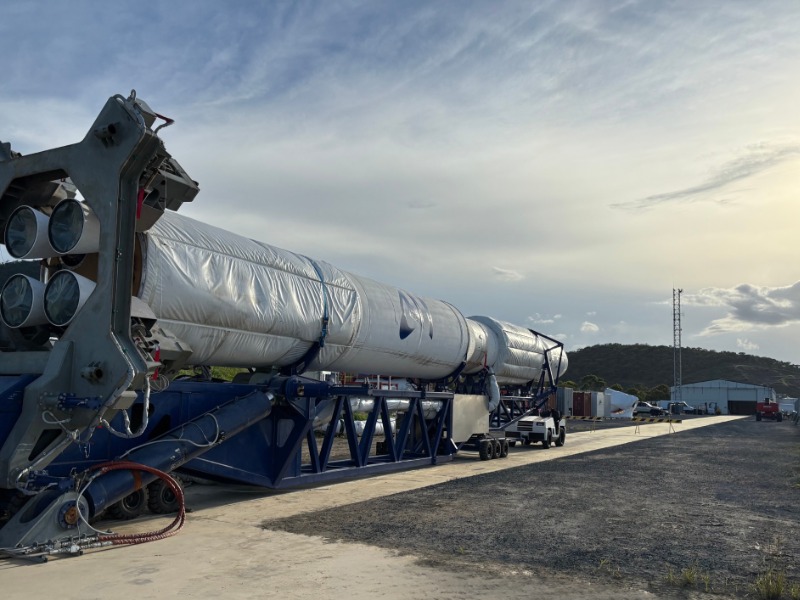Queensland rocket company Gilmour Space Technologies has announced the launch window for the first test flight of its Eris orbital vehicle will open on March 15, with a launch expected within days of that date.
With the Civil Aviation Safety Authority requiring a 28-day notification period, the March 15 date was the earliest possible launch date, according to Gilmour Space chief executive Adam Gilmour, who says the company is itching to get the rocket off the pad.
Gilmour Space made history in March last year when its Bowen spaceport was granted the first orbital launch facility licence in Australia, and when it secured the country’s first Australian Launch Permit in November for the Eris vehicle’s maiden flight.
With airspace arrangements finalised and mandatory notice given to the Australian Space Agency, the company has put itself into launch campaign mode and is preparing for liftoff.
While the company has been granted all its required licences and permits, there remains three technical documents outlining flight arrangements for the window that still need final approval from the regulators – two have been filed and one will go to the Space Agency within days.
Mr Gilmour says he has had a team of 40 engineers working on this final documentation, and once complete will swing into launch preparation.
The Eris rocket is currently sitting inside the Vehicle Assembly Building in a horizontal position at the Bowen launch facility and will be wheeled out to the pad in the next couple of weeks.

Now that the company is in launch mode, it has moved to constantly monitoring the weather. The two biggest determinants as to weather a launch can go ahead are the wind speed, and moisture (or rain).
“If the winds are too high, we can’t launch, and if there’s too much rain in the atmosphere, we can’t launch either, because [it impacts] telemetry, Mr Gilmour told InnovationAus.com. “And so that’s really important, and we will be closely monitoring weather in the two weeks up to the March 15.”
“As we approach the 15th, we have to make a decision on if we load up the oxidizer, the other gasses and stuff like that. We’ll make that determination roughly 12 hours before the window opens.
“But if the weather looks good, then basically we’ll go. We are ready.”
Now that the company is in launch campaign mode, it has also amplified its messages around expectations for launch.
It says while the window opens on March 15, “scrubs” are common in launch countdowns, it will likely take days and potentially even more than a week before it gets off the ground.
Given the weather dependency, if a cyclone comes through the area – and it is cyclone season through to the end of April – a delay could be substantial.
But Mr Gilmour is confident of the getting away within a week of the window opening.
And secondly, the company is making sure the public understands that reaching orbit on a first attempt of a new rocket design would be almost unheard of – even for national space programs, let alone a private startup.
SpaceX for example was only successful with its Falcon One rocket on its fourth attempt.
“It’s almost unheard of for a private rocket company to launch successfully to orbit the first time,” Mr Gilmour said.
“Whether we make it off the pad, reach max Q, or get all the way to space, what’s important is that every second of flight will deliver valuable data that will improve our rocket’s reliability and performance for future launches.”
Mr Gilmour says the launch is an important step in building sovereign space capability for Australia. Sovereign access to space – the ability to launch Australian satellites, from Australia – would means more high-tech jobs, greater security, economic growth, and technological independence.
Gilmour Space has about 15 staff based permanently at its Bowen Orbital Spaceport but will have about 40 employees at the site during the launch period.
The mission control facility will move to a 24-hour operation in the days before March 15, with two shifts of engineers and operators.
The company has committed to a daylight launch for the first test flight. While access to space does not rely on daylight, Mr Gilmour said they had decided that because the experience was new for everybody, daylight would be helpful.
“We have a lot of cameras on [the launch facility], and we want to have a good look at what’s going on. And if we need to fix anything, it’s so much better to fix stuff in daylight,” Mr Gilmour told InnovationAus.com.
“So yes, for this launch, we wanted it during the day. The regulators were pretty happy with that [decision] as well, because that made it a lot more manageable.”
Do you know more? Contact James Riley via Email.

